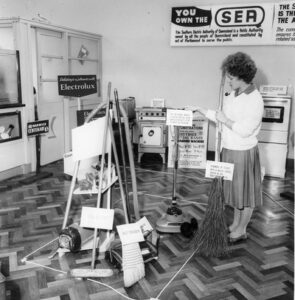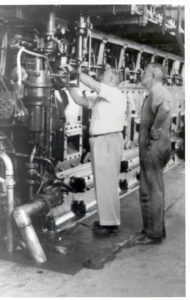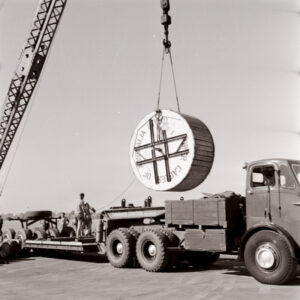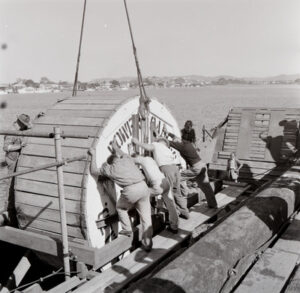1960’s Electric Memories
In February 1960, the Australian and United States Governments formally agreed to co-operate in space flight programs, which were being conducted by the US. Following the agreement, tracking stations were established in Australia at Woomera (South Australia), Carnarvon (Western Australia), Tidbinbilla and the Orroral Valley (Australian Capital Territory). A tracking station at Cooby Creek, near Toowoomba in Queensland was also later constructed as part of a world wide satellite-tracking network.
To provide electricity for the many and various pieces of equipment at the Cooby Creek tracking station, power was supplied by four turbo-generators, with one extra for emergency use. Plans were for six generators eventually – two at 250 kW and two 150 kW gas turbines. Two additional 250 kW diesel generators would be kept for emergencies. Supply from Southern Electric Authority of Queensland (SEA) was also available to power the site’s Australian office and canteen facilities, trailers, external lights and water and sewerage systems.
1960: Koombooloomba Dam
Koombooloomba Dam was handed over to the Cairns REB by the Premier, the Hon. Mr. Nicklin, at an official ceremony on 11 September, 1960.
A large party of official guests and visitors watched as the Premier, the Hon. Mr. G.F.R. Nicklin pressed a switch that sent a huge jet of roaring water from the dam in to the Tully River below. During his opening speech, Mr. Nicklin pointed out one of the unique features of the dam. Naturally-formed local pozzolanic material was used as a partial replacement of cement. It was the first time this new technique had been incorporated into a dam construction in Australia.
Roma: 1961
Roma Power Station was converted to natural gas. It was the first power station in Queensland to use this type of fuel for its plant.




1962: Maidenwell Lights-On Ceremony
Maidenwell, near Nanango, did not receive its supply until May, 1962. A report in the local newspaper in December, 1961, offered hope to residents in the Maidenwell and Neumgna area that supply was imminent to 15 consumers. The line to supply consumers in Merlwood, Cloyna and Windera had been completed. Poles were being delivered for the Speedwell and Abbeywood line and surveys were being conducted in the Brigooda, Durong and Chahpingah areas. Excitement mounted as the day came closer to Maidenwell receiving its electricity supply. At last the happy occasion arrived on 12 May, 1962, and was celebrated with a ‘Carnival of Lights’.
The small town of Maidenwell was simply engulfed with people, who came from every corner of the district on Saturday night, May 12, to witness the ‘Turning on of the Lights’ Ceremony and later to attend the ‘Queen of the Lights’ Ball.
The Manager of the Wide Bay Burnett Regional Electricity Board, Mr. S.A. Adams spoke about the advantages of electricity to the district. Following his speech, the Chairman of the Maidenwell Committee, Mr. L. Hancock invited the Shire Chairman, Mr. A.A. Anger to switch on the power. He thanked Mr. Hancock for the ‘great honour’ bestowed on him and addressed the crowd before the official switch-on was performed. Mentioning that Maidenwell was one of the last towns in the district to receive supply, he said ‘Most likely, as you have waited so long, you will appreciate it much better’. He emphasised the benefits that electricity would bring to the farmers on the land and the comforts to families at home and added a personal reflection.
From my own experience, it should help to create more harmonious relations between husband and wife. The husband does not come home for his evening meal to find his wife tired out and irritable from a hard day’s work of washing, scrubbing and polishing…
Mr. Anger switched on the electricity supply and flooded the town with light, to the cheers of the crowd. The ‘Queen of Lights’ Ball was held at the Maidenwell Hall, and from among 26 girls, Norma Bain was chosen to be the Queen with Glenys Cramp a close runner-up. Miss Bain wore a ‘Green and Gold Electricity Sash’ and a diamante tiara with a formal gown of white chiffon scattered with sprigs of blue sweet peas. Dancing at the Ball commenced and supper was served as part of the celebrations. At last, Maidenwell residents had reticulated electricity in their homes.


January 1963: Re-organisation of the Industry in South East Queensland
The Southern Electric Authority of Queensland (SEA) was given the responsibility of all the power generating stations in the area. New Farm Powerhouse and the larger Tennyson Power Station came under the control of the SEA. The responsibility for the distribution of power in Brisbane’s inner city limits became the responsibility of the Brisbane City Council (BCC). The operation also involved the transfer of staff from BCC to SEA. The official change-over date was 1 January 1963.
With New Farm and Tennyson generating plant added to the existing plant at Bulimba, the SEA claimed that by the end of 1963, SEA would have a generating capacity of 240 MW. Additionally, the Swanbank project was progressing.
1967: The First use of a Helicopter by SEA
Bringing power to O’Reilly’s Guest House and four adjacent homes on the Lamington Plateau required plenty of planning and the use of a helicopter. The area to be traversed was densely wooded and rugged, with deep gullies and cliff faces. Since most of the route passed through National Park, clearing a pathway was not permitted. To help with the difficult task, a small Bell helicopter was hired from Helicopter Utilities of Sydney. The helicopter’s main task was to take a light pilot line across the gullies. Then an intermediate heavier pilot line was winched across and used to pull across three conductors, one at a time. Keeping the lines away from the tree tops was one of the major problems. It was an historic occasion, with newspaper and television reporters present to record the difficult moves.
Bringing power to the Lamington Plateau was claimed to be one of the most spectacular and difficult projects undertaken by SEA. A happy festive season was planned for the family and the visitors at the O’Reilly’s Guest House and four adjacent homes when, for the first time, power lines were energised at 11kV and electricity was readily available on Wednesday, 22 November, 1967.
The pioneering O’Reilly family had lived in the mountains and rainforest for more than half a century before power arrived, with their first home the usual pioneer’s slab and bark hut with candles, slush lamps and the glow of a log fire for illumination. From the early 1920s when a guest house was built to welcome visitors to share the grandeur of the rainforest, carbide lamps with decorative mantles were fitted in the main rooms and kerosene was used to provide light in the bedrooms. In 1937, a diesel-powered generating plant was installed to provide electric lighting in the rooms and for pumping water up to the guest house from the Moran Falls below.
Coming to a decision about the safest route to take for the power lines proved to be an exacting task. At last the route was finalised and work began to clear the way through. Apart from the deep, wooded valleys and rugged, extremely steep cliffs to traverse, there was the transportation of materials to address. The distance across the gorge from Pat’s Bluff to Castle Crag, which would be the longest span for the extension, was 4744 feet (1446 m).
Most of the planned route passed through National Park and its significant scenic beauty had to be preserved and clearing a pathway for the line was not permitted. In similar difficult situations when deep valleys had to be traversed, as in North Queensland for a section of the 132kV transmission line between Clare and Garbutt, rocket propulsion was used to carry light cord lines over distances of around 1,000 feet (around 304 m) between the towers and then normal methods were used to draw the conductors through The distance to span for the Lamington Plateau project was too far for rockets to be used, so a helicopter was brought in to tackle the job. It was the first time a helicopter had been used on a construction project of this type.
A major difficulty for the team was keeping the pilot line away from the dense rainforest canopy. The spectacle was watched by guests at the Lodge, some taking picnic lunches to make it a day out. Television and newspaper crews were also at the scene to record the feat. The extension to the Lamington Plateau was estimated to cost around $25,000 and the SEA was appreciative of the ‘good deal of hard work by layout and construction personnel’ and said that it was ‘an achievement of great importance to the people of the mountains’.

1967
Swanbank A Power Station was commissioned.
1968
Collinsville Power Station commissioned.
Winton Powerhouse taken over: 1968
Winton’s Powerhouse was incorporated into Townsville Regional Electricity Board from 1 May, 1968 and began to receive its supply by transmission line from Hughenden.
